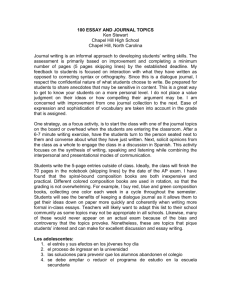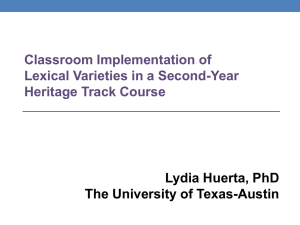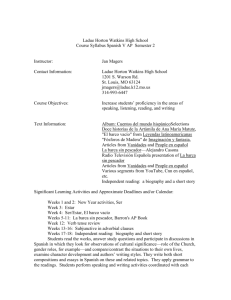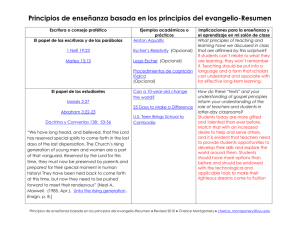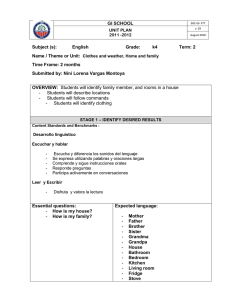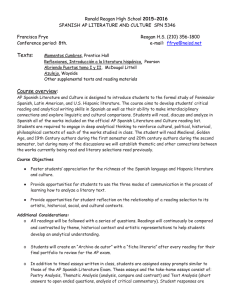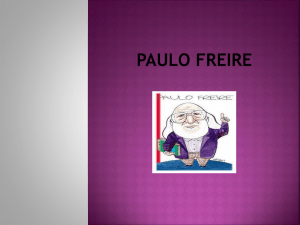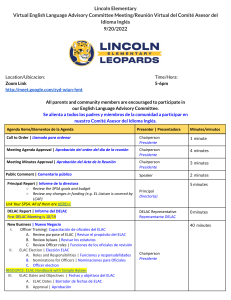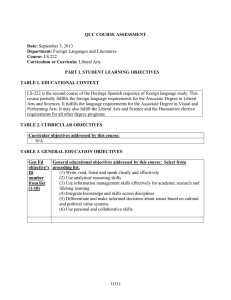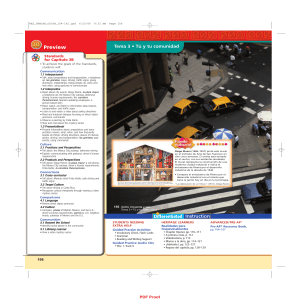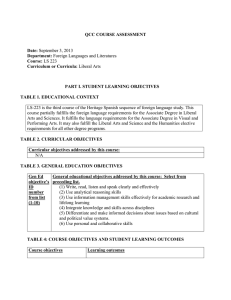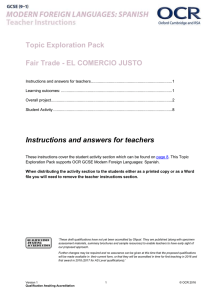Unit Plan: El Camino de Santiago
advertisement
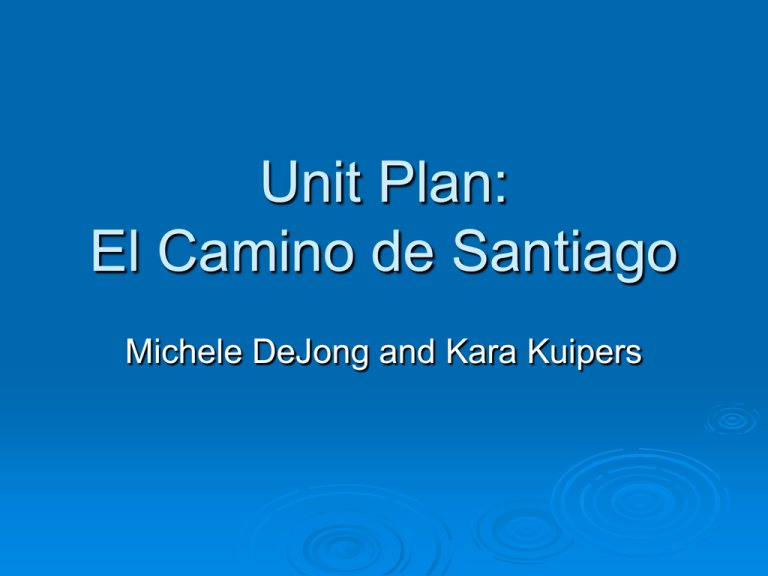
Unit Plan: El Camino de Santiago Michele DeJong and Kara Kuipers Day One: El Camino Introductory discussion: ¿Qué significa “camino”? 3 minutes • The students will most likely have heard this word, but the purpose of a quick discussion is to expand their knowledge. • For this lesson, link “camino” to a road, hike, or excursion. Exploratory activity: ¿Cuántas millas has caminado en una excursión o en un camino? 5 minutes • Draw a line across the board, labeling distances up to 500 miles (800 km). • After discussing with a group, students come up to the board and mark how far they have ever traveled on a hike. ¿Qué relación existe entre estas cosas? Vocabulary • • • 15 minutes Students work in pairs, brainstorming about what items they would need to take on the Camino de Santiago. Make a master list on the board of the vocabulary that the students have come up with. Let the words that they come up with be the vocabulary list for the unit. Make sure to add some of your own vocabulary if they missed some important words. Encourage the students to write down the translations for the words that are new to them. ¿Qué cosas necesitas para hacer el camino? palabras en español La mochila El saco de dormir Los zapatos El sombrero Una cámara El casco de bicicleta La cantimplora Las botas El cepillo de dientes Ropa traducción al inglés (las palabras que no sabes en español ) Activity: ¿Qué cosas vas a llevar en el camino? 15 minutes ¿Cómo quieres hacer el camino? Escoge un modo de transporte. Instrucciones: Elige 5 cosas para llevar en el camino. Después de terminar la actividad, debes saber lo que tu compañero va a llevar en el camino y también debes poder adivinar su modo de transporte. ¿Llevas ________ verde? ¿Llevas ________ azul? ¿Llevas ________ amarillo? ¿Llevas ________ rojo? ¿Llevas ________ morado? ¿Qué modo de transporte va a usar tu compañero? _____________________ Homework: ¿Quién es Santiago? 1. Go to the following website: http://www.jrnet.com/travel/articles/santiago.html …¿Qué encuentras?... 1.Who was Santiago? 2.Where was he buried? 3.How did his body get there? 4.What is one new thing this website tells you about the Camino de Santiago? 2. Now visit a few of the links at the bottom half of the web page. You are planning on traveling the Camino de Santiago over next summer. List two interesting things that you learned that will help you on your journey: 1. 2. Tarea Hiciste el Camino de Santiago el mes pasado y ahora estás en casa con tu amigo Alberto. Él quiere saber todo sobre el Camino. Él tiene algunas preguntas para ti. Alberto: ¡Hola! ¿A qué país viajaste el mes pasado? Tú: Alberto: ¿Qué hiciste allí? Tú: Alberto: ¿Fue difícil? Tú: Alberto: ¿Por qué? Tú: Alberto: ¿Con quién viajaste? Tú: Alberto: ¿Por qué viajaste con él / ella? Tú: Alberto: ¿Qué cosas llevaste y por qué? Tú: Alberto: ¡Qué divertido! Ahora, muéstrame tus fotos…. Day two Listening Activity Read aloud to the class. Part 1: ¡Hola! Me llamo Raquel. El verano pasado, fui al norte de España para hacer el Camino de Santiago. Fui con mis amigas. Llevé una mochila roja, unas botas grandes y un saco de dormir. Part 2: Mis amigas y yo empezamos en la ciudad de León. La ciudad de León es muy grande y tiene una iglesia muy antigua. El primer día fue muy fácil. Mis amigas y yo caminamos 10 kilómetros antes de comer en un restaurante. Comimos pan con queso y frutas secas. Part 3: El segundo día, conocí a un hombre. El hombre se llama Antonio. Antonio es de Barcelona. Barcelona es una ciudad en España. Hablé con Antonio por todo el día. Antonio es católico. El último día del viaje, llegamos a la ciudad de Santiago de Compostela. Fuimos a la misa con nuestro amigo Antonio. Part 4: Por la noche, todas las personas celebraron. Todos estaban muy contentos porque habían terminado el camino. Mis amigas y yo estábamos contentas y fuimos a un restaurante para celebrar. Teacher will read the first section, give time for students to answer the questions, read it again, and give students more time to answer. Then go on to the next section. • Part 1: ¿Cómo se llama la chica? ¿Adónde fue ella? ¿Qué llevó ella? • Part 2: ¿Cuántos kilómetros caminaron? ¿Qué comieron las chicas? • Part 3: ¿De dónde es Antonio? ¿Adónde fueron Antonio y Raquel el último día del viaje? • Part 4: Todos estaban ______________ . ¿Adónde fueron Raquel y sus amigas para celebrar? Making a travel brochure 10 minutes Put the students into groups of three or four. Hand out a sheet of paper with the outline for a Camino de Santiago travel guide. Give each group a couple of markers to make a colorful brochure about the trail. Their homework questions and vocabulary list should help them. ¿Quiere Ud. hacer el Camino de Santiago? Ud. puede hacer el camino usando varios medios de transporte: Hay muchas cosas que ver en el camino: Para el camino, Ud. debe llevar: 3 cosas que Ud. necesita saber sobre el camino: Reading Activity – scaffolding 30 minutes Before you start, go over the first three questions from the website homework about Santiago. La historia de Santiago Santiago, quien también se llama Juan evangelista, fue pescador hasta que Jesús le llamó para ser su discípulo. Por su carácter violento e impulsivo se le ha denominado "Hijo del Trueno". La tradición le identifica como el Apóstol que evangelizó la Península Ibérica (la zona actual de España y Portugal). El rey de Judea no quería a los cristianos, y condenó a Santiago a la muerte por decapitación. Fue el primer mártir de los apóstoles. La tradición afirma que Santiago fue trasladado hasta el norte de España, la zona de la actual ciudad de Santiago de Compostela. ¿Qué piensas? ¿Por qué fue importante Santiago? ¿Por qué existen un camino y una ciudad con su nombre? Reading Activity – scaffolding 30 minutes Working alone 1. The students read the text once on their own, drawing a circle around words that describe Santiago and a triangle around names of places. 2. Next they should underline any sentence that they do not understand. 3. Focusing on those sentences, they should draw a square around the word(s) that they think are tripping them up. Pair work • Have the students get together with a partner and try to figure out the meanings of the words with squares. Whole class discussion • Go over the hardest sentences together. Ask a student to sum up each sentence in English. Pair work • Students should work on the reflection questions together. Whole class discussion • Brainstorm together about why there might be a road and city in honor of Santiago. Homework: El primer día ¿Dónde empezaste? ¿Cuántos kilómetros caminaste? ¿Qué viste? El segundo día ¿Cuántos kilómetros caminaste? ¿Qué viste? ¿Conociste a alguien? ¿ Viste a alguien? Una iglesia El tercer día ¿Qué comiste? ¿Cuántos kilómetros caminaste? ¿Dónde terminaste? ¿Viste la iglesia? Santiago de Compostela Day three: JAVIER DE ARAMBURU, ESCRITOR E HISTORIADOR, ESCRIBE SOBRE LA PEREGRINACIÓN -¿Por qué se peregrinaba en la Edad Media? - Los santos tenían un simbolismo de héroes. Habían muerto por Dios y hacían milagros. Existía la creencia popular de que acercándote al santo, obtendrías un beneficio para la salud o el perdón de los pecados. Por eso, tener una reliquia era algo muy importante. La gente robaba los huesos de los santos. Por otra parte, se valoraba mucho el sacrificio de la peregrinación. No podemos mirar el camino con los ojos de ahora. Los peregrinos pasaban hambre, sufrían robos, se topaban con guerras de señores feudales. Muchos no regresaban a casa. - ¿Por qué cree que se peregrina en el siglo XXI? - Hay quien peregrina con verdadera devoción o por una promesa y quien lo hace por un interés lúdico-deportivo. Pero la mayoría de los que van, confiesan que han vuelto cambiados. Eso ocurre porque durante el camino hay mucho tiempo para pensar, cosa que no sucede habitualmente. Vas con muy poca cosa encima y te das cuenta de que la vida no consiste en tener muchas cosas. READING ACTIVITY whole class comprehension 1. 2. 3. 4. 5. 20 minutes Find all the cognates in the reading. Find all the verbs in the past tense. Find all the verbs in the present tense. Pick out words that the students still do not know. Read the paragraphs again. Ask comprehension questions to the whole class. Discussion • 5-10 minutes Why do people hike the Camino de Santiago? Ask for answers from students and list them on the board. Possibilities: • • • • Exercise Travel Religion Self-reflection Speaking Activity: El teléfono • • • 20 minutes Arrange the desks into rows of six. Students take turns as speakers and listeners. After each round, they move back one seat. (A, K, and M refer to the stories of Antonio, Kate, and María —see next slide) The sixth time, the story should be told back to the original person. 1st round: yo speakers→ 1 ↓A listeners→ 2 speakers→ 3 ↓K listeners→ 4 speakers→ 5 ↓M listeners→ 6 2nd round: él 3rd round: él 6 ↓M 1 5 ↓K 6 2 ↓A 3 4 ↓K 5 4th round: él 5th round: él 6th round: tú 4 ↓A 5 3 ↓M 4 2 ↓K 3 1 ↓M 2 6 ↓K 1 5 ↓A 6 4 ↓M 5 3 ↓A 4 2 ↓M 3 1 ↓K 2 6 ↓A 1 TELEPHONE GAME Teacher: Cut out each role and make enough copies for your class. Each group of six students should have a copy of each of the three different roles. Three students will play these roles, telling their partner why they walked the Camino de Santiago and what they did. In the next round, students change seats and try to repeat the same story to the next student (see previous slide). On the sixth round, it will be fun to compare the final story with the original story! Ejemplos: • A (Antonio): Hice el Camino de Santiago para hacer ejercicio. Soy maestro de educación física. • K (Kate): Hice el Camino de Santiago para ir de vacaciones. ¡Me encanta caminar! • M (María): Hice el Camino de Santiago para aprender más sobre mi fe. Aprendí mucho de Dios. Further Discussion up to 20 minutes Topics to discuss (in English, if necessary) • • • The different hikes that the students can do in the United States and for what reasons people do them. Means of transportation: why do people walk so little in the United States? How religion is connected to culture in different countries (U.S. vs. many Spanishspeaking countries). • El Camino de Santiago • Other examples…?
